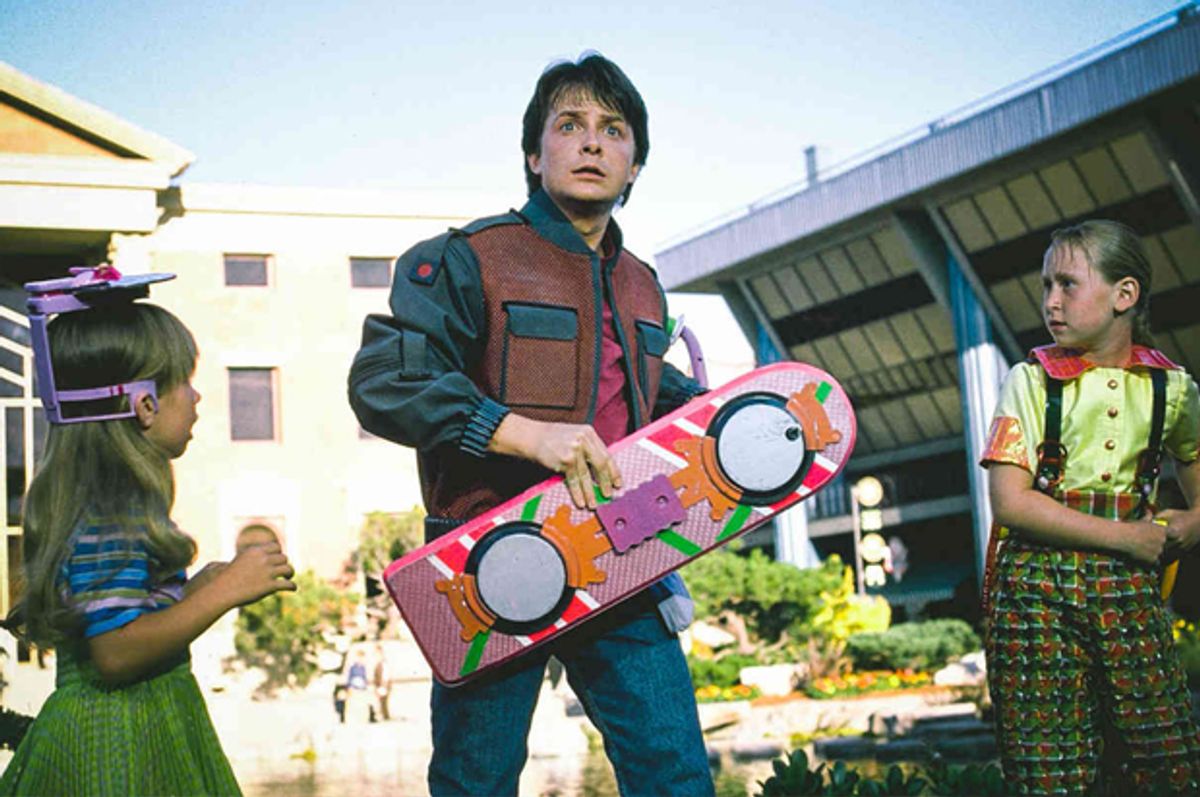Let’s get the obvious out of the way: Wednesday is October 21, 2015 – the date visited by Marty McFly in the time-traveling DeLorean 26 years ago in “Back to the Future: Part II” – and we do not have hoverboards. I repeat, hoverboards do not exist — these toys don't count.
In fact, not much of the technology that appears most ubiquitously in the 1989 classic seem to have materialized. Our cars don’t run on garbage — indeed, as a hilarious College Humor skit observed, our refusal to break free from carbon fuels has destroyed our planet in the twenty-six years since the film’s release — and our highways are still confined to terra firma. That’s just the tip of the iceberg: We don’t have self-lacing sneakers or self-drying jackets, there are no robots to pump our gas, our weather forecasts are still unreliable, doorknobs haven’t been phased out by thumb scanners, and miniature pizzas still remain fun-sized after you stick them in an oven.
Instead of merely observing where “Back to the Future: Part II” was wrong — or, for that matter, noting the occasional odd area where it may have actually been prophetic (could the Chicago Cubs win the World Series?) — perhaps it would be more useful to analyze why it was wrong in certain areas. What does that tell us about how we viewed the near-future back in the late ‘80s and how does that compare to other famous sci-fi stories that also made their own prognostications? More importantly, how can we apply those lessons to the predictions we might make today?
When it comes to technological innovation, the practical beats the glamorous
Because science fiction writers are meant to depict future worlds that audiences will find entertaining, they tend to predict technological advancements that are wondrous to behold. The problem, of course, is that ideas which look good on a page or screen often don’t make sense in real life. Jet packs, for example, were a staple of comic books, TV shows, and movies in the mid-twentieth century, but when they were invented in 1961 it became apparent that they were too fuel-inefficient for average consumers and too high-risk for the military (a soldier in a jet pack makes for an easy target).
Similarly, although space age predictions about regular trips to the stars (see “Star Trek"), moon bases ("Project Moon Base"), and martial colonies ("Total Recall") seemed plausible when our budget regularly included generous allocations to NASA, the end of the Cold War wound up removing a major incentive behind American investment in space exploration — our competition with the Soviet Union.
Incidentally, this rule explains why the flying cars of “Back to the Future: Part II” aren’t a reality. They might look cool, but they’re also expensive, sensitive (they’d be hard to drive in bad weather), and dangerous (even the slightest malfunction would cause you to fall out of the sky).
Medicine has improved, but the basic rules of human biology are unchangeable
Though it often isn’t remembered, “Back to the Future: Part II” did take a stab at biotech prediction. In one scene, Doc Brown tells Marty that he went to a rejuvenation clinic that repaired his hair, transfused his blood, and replaced his spleen and colon to add “thirty to forty years” to his life. This is consistent with a long history of sci-fi writers making absurdly optimistic predictions about how technology will improve our lives — certainly we are farther along now than we were in 1989, but nowhere near that level.
The same can be said for “Brazil,” which correctly predicted our obsession with plastic surgery but grossly overestimated how long a human lifespan could be extended, or “Blade Runner,” which assumed we would have genetic clones (or replicants) that could perform slave labor or serve as organ farms.
This isn’t to say that we haven’t made remarkable advances in medicine since the 1980s, but scholars tend to agree that science fiction and fantasy writers often engage in wish fulfillment (usually assuming we will be immortal or at least live for significantly beyond the usual 75-to-100 year life expectancy) instead of making reliable predictions.
When technological progress merges with politics, the results tend to be more rather than less democratic
The future depicted in “Back to the Future: Part II” may be utopian from a technological standpoint, but it is distinctly dystopian when it comes to the social order. Doc Brown makes an offhand reference to how Marty McFly’s son is arrested, tried, and convicted in the same day (because lawyers have been banned, har har), while Biff’s grandson is able to publicly bully Marty Jr. with apparent impunity. Fortunately, as economists Daron Acemoglu and James Robinson have pointed out, countries with democratic institutions tend to thrive technologically when compared to their despotic counterparts. Since it can be assumed that a nation which rushes suspected criminals into prison is far from democratic, the world of “Back to the Future: Part II” can be safely lumped in with the unrealistic high-tech dystopias seen in films like “Blade Runner,” “Fahrenheit 451” or “Logan’s Run.”
As for the bullying… Well, College Humor's skit addressed this best when it joked that while there are still bullies, our tendency to shame those who publicly abuse their victims has caused much of the worst bullying to occur anonymously online. The notion that a Griff could brazenly assault a weakling in the light of day without alerting the police and causing a social media scandal seems practically quaint.
None of these observations are meant to detract from “Back to the Future: Part II.” I rewatched the film twice for this article and can attest that, as a moviegoing experience, it remains as smart, funny, and engaging as ever. That said, if future science fiction scribes want to write about the future in a way that will prove prophetic, they may be well-advised to learn from exactly how that film went wrong.

Shares